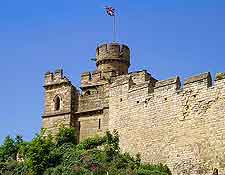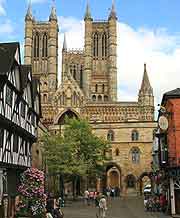Lincoln History Facts and Timeline
(Lincoln, Lincolnshire, England)

Lincoln has a long and rich history that stretches back some 2,000 years. From a prehistoric settlement, it's grown into a city that is steeped in Roman, Anglo-Saxon, Norman and Victorian heritage.
Lincoln's story started when a group of Iron Age people made their home around Brayford Pool. They called their settlement 'Lindon', or 'place by the pool'.
Roman and Medieval Times
The Romans arrived in Lincoln in 54 AD. They quickly established a military fortress here and named it 'Lindum'. The town grew in importance and in 90 AD even became a 'coloniae', one of only four in the whole of Britain. Henceforth, it was to be known as Lindum Colonia. Later, in the 4th century, it became the capital of the eastern part of Roman Britain. Even when the Romans departed, Lincoln maintained some of its status as an important town in the region. The Danes named it one of the five main 'burghs' of Danelaw.
The arrival of the Normans in 1068 led to the construction of many fine medieval buildings. Some survive to this day, as does a great deal of the city's original street plan. Built high above the River Witham, the 11th-century castle was intended as an invulnerable stronghold. Completed in the latter part of the 12th century, the Bishop's Palace was to become one of the city's most important buildings. At the time of its eventual completion in 1311, the cathedral was the tallest in the world.
Medieval Lincoln was, however, not an entirely peaceful place. In 1141, Lincoln Castle was laid siege by King Stephen. When the besiegers themselves came under attack by Empress Matilda and the forces of Robert, 1st Earl of Gloucester, a fierce battle ensued in the streets. Finally, Stephen was defeated and peace restored.
By 1157, Lincoln had been granted a Royal Charter by King Henry II. The king even had his own residence in the city. As the medieval period drew to a close, however, Lincoln suffered a number of setbacks. These included an earthquake, the Black Death and a serious decline in the city's wool trade.

From the 16th to 19th Century
The early decades of the 17th century brought few improvements for Lincoln. The city suffered further destruction during the English Civil War. Whilst the majority of the city's inhabitants supported Parliament, the city changed hands numerous times. The Parliamentarians finally prevailed over the Royalists in the upper part of the city, holding it until the end of the war in 1646.
It wasn't until the 19th century and the arrival of the Industrial Revolution that Lincoln began to enjoy a period of rapid industrial growth and the expansion of its population. Such growth was spurred on by the arrival of the railway in 1846. As time went on, the city was forced to respond to pressures on space. Terraced housing sprang up in the eastern part of Lincoln and new public amenities were built. These included the city's first park and arboretum.
20th-Century Times in the City
For most of this period, Lincoln remained an industrial city. In 1915, agricultural engineers William Foster and Son invented the first fighting tank here, known as 'Little Willie' in response to the outbreak of the First World War.
In more recent times, Lincoln has flourished as a tourist city. Today, the city is perhaps best known for its Christmas Market, reputed to be the largest in Britain.
 Lincoln has a long and rich history that stretches back some 2,000 years. From a prehistoric settlement, it's grown into a city that is steeped in Roman, Anglo-Saxon, Norman and Victorian heritage.
Lincoln has a long and rich history that stretches back some 2,000 years. From a prehistoric settlement, it's grown into a city that is steeped in Roman, Anglo-Saxon, Norman and Victorian heritage.